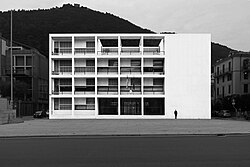
Back عمارة فاشية Arabic Arquitectura feixista Catalan Faschistische Architektur German Arquitectura fascista Spanish معماری فاشیستی Persian Architecture fasciste French אדריכלות פשיסטית HE Architettura del periodo fascista Italian Architettura fassista LMO Architetura fassista PMS
| Fascist architecture | |
|---|---|
Top: Palace of Italian Civilization, EUR, Rome, Italy. Middle left: The Palace of Justice, Milan, home to the Tribunal, designed by Marcello Piacentini and built between 1932 and 1940; Middle right: The CSIC honouring Franco's victory in the Spanish Civil War, in Madrid, Spain. Bottom left: The New Reich Chancellery in Berlin, Germany, built between 1938 and 1940; Bottom right: Ehrentempel (Honor Temples) two structures built in Munich in 1935, housing the sarcophagi of the 16 Party members who died in the failed Beer Hall Putsch. | |
| Years active | 1920s – early 1940s (Italy and Germany), 1950s and later (Spain, Portugal and others) |
| Location | Italy, Germany, Spain, Portugal and more |
| Influences | Rationalism, Stripped Classicism, Classical architecture |
| Influenced | Other totalitarian architectural styles |
| Part of a series on |
| Fascism |
|---|
 |
















Fascist architecture encompasses various stylistic trends in architecture developed by architects of fascist states, primarily in the early 20th century. Fascist architectural styles gained popularity in the late 1920s with the rise of modernism along with the ultranationalism associated with fascist governments in western Europe. Fascist styles often resemble that of ancient Rome, but can extend to modern aesthetics as well. Fascist-era buildings are frequently constructed with particular concern given to symmetry, simplicity, and monumental size, especially for public buildings.
Benito Mussolini utilised several styles of architecture, incorporating classical elements into modern Rationalist architecture to convey a sense of continuity with ancient Rome.[3]
National Socialist architecture under Adolf Hitler is often associated with Italian Fascist Architecture. It also utilised new styles of architecture but favoured Stripped Classicism over modernism, in an attempt to unify the people, mark a new era of nationalist culture, and exhibit the absolute rule of the state.[4]
In some cases, such as the Italian "foundation cities" (città di fondazione), the new architecture also followed the needs of the corporatist economic model: smaller buildings inspired by local architecture were sometimes favoured to create small rural cities. This practice of moving people out of the city centers and into rural areas[5] to farm or to work in mines, especially during the time of autarchy, is similar to disurbanism.
- ^ "Il palazzo della sede centrale compie 80 anni". cnr.it.
- ^ Bottini, Fabrizio (18 September 2015). "Genova e la «City» fascista". cittaconquistatrice.it.
- ^ Nicoloso, Paolo (19 February 2023). "Mussolini architetto e urbanista con Paolo Nicoloso". YouTube.
- ^ "The Fascinating World of Fascist Architecture". Retrieved 2012-02-04.
- ^ Bonfante, Francesca; Monica, Luca (2023). "Nuove città e nuove campagne in Italia, dalla Città corporativa alla Ricostruzione". Famagazine. Ricerche e Progetti Sull'architettura e la Città (62–63): 21–37. doi:10.12838/fam/issn2039-0491/n62-63-2022/935. hdl:11311/1233736.
© MMXXIII Rich X Search. We shall prevail. All rights reserved. Rich X Search




